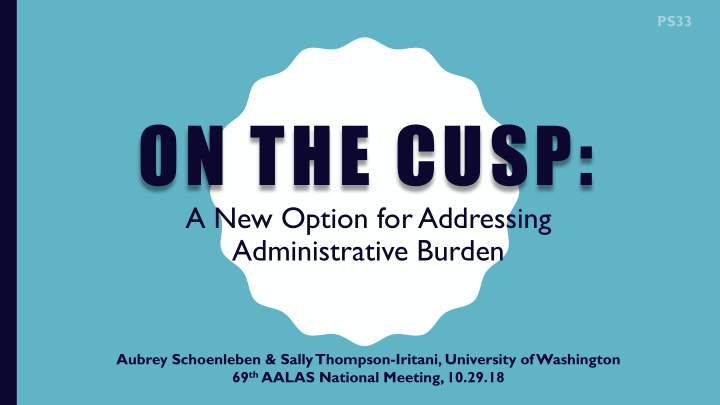



PS33 ON THE CUSP: A New Option for Addressing Administrative Burden Aubrey Schoenleben & Sally Thompson-Iritani, University of Washington 69 th AALAS National Meeting, 10.29.18
BACKGROUND: • Protocol preparation and review extremely time Draft by Reviewer or Resident and effort intensive – creation of standard procedures topped UW researcher wish list. Veterinary Pre-Review • Transition to electronic protocol management system motivated development of standard procedures. IACUC Review • Collaborative process for development and approval of standard procedures. Approval • Current library includes 897 standard substances and 654 standard procedures
IT’S NOT JUST US… • Animal research regulations identified as a top source of administrative burden. • 33% of investigators describe protocol review process as “unnecessarily complex and time consuming.” • Identifying a mechanism to reduce the time and effort needed to create and review protocols would reduce 1. National Science Board. 2015. Reducing Investigators’ Administrative Workload for Federally this burden for researchers and Funded Research. Retrieved from: https://www.nsf.gov/pubs/2014/nsb1418/nsb1418.pdf 2. 21st Century Cures Act. January 2017. Retrieved from: https://www.congress.gov/114/bills/hr34/BILLS-114hr34enr.pdf IACUCs. 3. Federal Demonstration Partnership. 2012. Faculty Workload Survey Research Report. Retrieved from: http://sites.nationalacademies.org/cs/groups/pgasite/documents/webpage/pga_087667.pdf
Goal: Develop an online resource where CUSP participating institutions can share SHARING standard procedures SITE used in animal care protocols. CUSP = Compliance Unit Standard Procedure Partnered with Federal Demonstration Partnership (FDP)
WORKING GROUP: CUSP Working Group Data Import & Export Species Team Michelle Brot, Jaret Langston Denise Ancharski-Stutler Aubrey Schoenleben, Sally Thompson-Iritani Data Organization Procedure Team Scott Bury, Eva McGhee Eva McGhee Data Storage & Maintenance Form Team Madeline Budda, Curtis Van Slyck Jeremy DeRicco, Robert Kerley Currently 90 members from 50+ institutions
WHAT HAVE WE BEEN UP TO THIS PAST YEAR? Initial Site Project Site Design & Impact on Working Group Proposal Pilot Development & Function Burden Formed Approved T esting In progress! March 2017 October 2017 Winter 2019
1. DATA ORGANIZATION: PICK LISTS • Procedures will be characterized by various attributes, such as species or procedure type. • Granular organization à Pick lists • Pick lists will be dynamic; can be Cranial combined with free text search. Cardiac Thoracic Survival • Pick lists developed for species, Behavior substance type, 2 procedure types Non-Survival T ests (euthanasia, blood/sample Surgery collection) Procedure Type
1. DATA ORGANIZATION: PICK LISTS • Procedures will be characterized by various attributes, such as species or procedure type. • Granular organization à Pick lists • Pick lists will be dynamic; can be Cranial combined with free text search. Cardiac Kidney Survival • Pick lists developed for species, Behavior substance type, 2 procedure types Non-Survival T ests (euthanasia, blood/sample Surgery collection) Procedure Type
2. PROCEDURE LIFE CYCLE Archive Procedure Renew New Procedure Procedure (3 year lifespan) Endorse Procedure Edit Delete Procedure Procedure
NEXT STEPS: DEVELOPMENT PHASE • Currently building a model of the database in Microsoft Access. • This exercise will help us determine the underlying data architecture and work out the necessary logic needed for search and filter features. • Code can be easily transferred to the CMS the site will be built on.
NEXT STEPS: DEVELOPMENT PHASE Goal: To create a functional procedure sharing database with a user friendly interface. • Initial testing of system. Alpha • Identify major bugs, usability issues or feature gaps. • Largely performed by tech team • 2-3 institutions • Second phase of pre-release testing; Beta simulates how system will be used in real life. • Identify bugs and other technical issues. • Wide variety of users need to participate. • 6-8 institutions • Release to working group; simulates how system will be used in real life. Pilot • Evaluate usability and provide feedback on the system. • Wide variety of users need to participate. • 15-20 institutions Timeline: Approximately 2 months/phase
QUESTIONS? Wa nt t o help? E mai l A u b rey Sch oe n l e b e n ( au b reys @ u w. e d u ) or Sal ly T h omp s on- I ri tan i ( s ti 2 @ u w. e d u )
21 ST CENTURY CURES ACT RFI: DRAFT REPORT O pen fo r c o mment Fa ll 2018!
BENEFITS: • Reduced administrative burden for researchers, IACUCs and IACUC staff. • Support development of high quality animal care protocols. • Provide consistency within and across institutions. • Support knowledge sharing within the animal welfare compliance community.
SITE GUIDELINES: • Participating institutions have the opportunity and expectation to contribute. • Each institution is expected to maintain their contributions as updates occur. • Each procedure must be reviewed and approved by the individual institution’s IACUC prior to use. • The specific content of procedures would not be reviewed, approved, or endorsed by the FDP or regulatory agencies.
DATA IMPORT & DATA EXPORT Low T ech High T ech Manual JSON CSV (Excel) API Image Source: www.flrunning.com
DATA ORGANIZATION: PARENT/CHILD MODEL Parent Procedure Variation #1 Variation #2 Variation #3
3. SITE ACCESS & USER ROLES
3. SITE ACCESS & USER ROLES
Recommend
More recommend